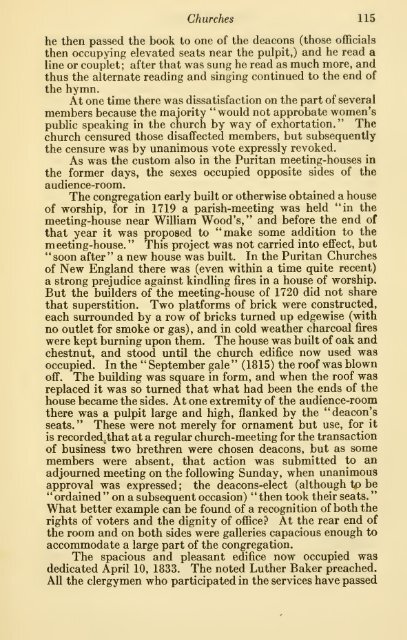History of Swansea, Massachusetts, 1667-1917; - citizen hylbom blog
History of Swansea, Massachusetts, 1667-1917; - citizen hylbom blog
History of Swansea, Massachusetts, 1667-1917; - citizen hylbom blog
Create successful ePaper yourself
Turn your PDF publications into a flip-book with our unique Google optimized e-Paper software.
Churches 115<br />
he then passed the book to one <strong>of</strong> the deacons (those <strong>of</strong>ficials<br />
then occupying elevated seats near the pulpit,) and he read a<br />
line or couplet; after that was sung he read as much more, and<br />
thus the alternate reading and singing continued to the end <strong>of</strong><br />
the hymn.<br />
At one time there was dissatisfaction on the part <strong>of</strong> several<br />
members because the majority "would not approbate women's<br />
pubHc speaking in the church by way <strong>of</strong> exhortation." The<br />
church censured those disaffected members, but subsequently<br />
the censure was by unanimous vote expressly revoked.<br />
As was the custom also in the Puritan meeting-houses in<br />
the former days, the sexes occupied opposite sides <strong>of</strong> the<br />
audience-room.<br />
The congregation early built or otherwise obtained a house<br />
<strong>of</strong> worship, for in 1719 a parish-meeting was held "in the<br />
meeting-house near William Wood's," and before the end <strong>of</strong><br />
that year it was proposed to "make some addition to the<br />
meeting-house. " This project was not carried into effect, but<br />
"soon after" a new house was built. In the Puritan Churches<br />
<strong>of</strong> New England there was (even within a time quite recent)<br />
a strong prejudice against kindling fires in a house <strong>of</strong> worship.<br />
But the builders <strong>of</strong> the meeting-house <strong>of</strong> 1720 did not share<br />
that superstition. Two platforms <strong>of</strong> brick were constructed,<br />
each surrounded by a row <strong>of</strong> bricks turned up edgewise (with<br />
no outlet for smoke or gas), and in cold weather charcoal fires<br />
were kept burning upon them. The house was built <strong>of</strong> oak and<br />
chestnut, and stood until the church edifice now used was<br />
occupied. In the " September gale " (1815) the ro<strong>of</strong> was blown<br />
<strong>of</strong>f. The building was square in form, and when the ro<strong>of</strong> was<br />
replaced it was so turned that what had been the ends <strong>of</strong> the<br />
house became the sides. At one extremity <strong>of</strong> the audience-room<br />
there was a pulpit large and high, flanked by the "deacon's<br />
seats. " These were not merely for ornament but use, for it<br />
is recorded^that at a regular church-meeting for the transaction<br />
<strong>of</strong> business two brethren were chosen deacons, but as some<br />
members were absent, that action was submitted to an<br />
adjourned meeting on the following Sunday, when unanimous<br />
approval was expressed; the deacons-elect (although t^ be<br />
"ordained" on a subsequent occasion) "then took their seats.<br />
What better example can be found <strong>of</strong> a recognition <strong>of</strong> both the<br />
rights <strong>of</strong> voters and the dignity <strong>of</strong> <strong>of</strong>fice? At the rear end <strong>of</strong><br />
the room and on both sides were galleries capacious enough to<br />
accommodate a large part <strong>of</strong> the congregation.<br />
The spacious and pleasant edifice now occupied was<br />
dedicated April 10, 1833. The noted Luther Baker preached.<br />
All the clergymen who participated in the services have passed<br />
"

















